Phase 1 of the route from London to Birmingham includes 16km of tunnels running under the Chiltern Hills, a giant project that will be carried out by two 170m long tunnel boring machines and more than 1,000 workers. Santa Barbara, the patron saint of tunnellers, will oversee the works, Tom Lowe reports
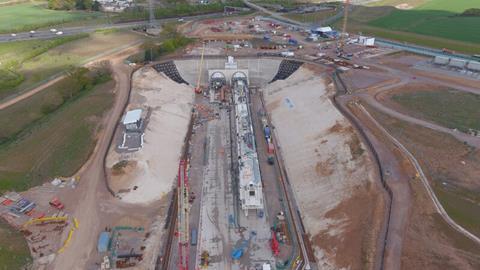
The first press visit to HS2’s immense South Portal site since covid-19 restrictions were relaxed did not get off to the smoothest of starts. Seconds after arriving at the headquarters of the project to build not only the £100bn railway’s longest tunnels, but also the UK’s longest rail viaduct, Building was informed that there had been a power cut.
The cause of the outage was unknown, but a member of HR, while leading reporters through an unlit corridor to a changing room, was quick to make it clear that only the visitors’ induction centre was affected. A few minutes later, as the press were changing into bright orange overalls, the staff member reappeared to insist that the rest of the site was definitely operating as normal, just in case we had misheard.
It is clear that the controversy surrounding HS2 – not only over its staggering price tag, but also from environmentalists campaigning against perceived damage to natural habitats along the route – has put the project’s comms team on high alert. And, after the debacle of Crossrail, the prospect of another major UK taxpayer-funded infrastructure project descending into farce is simply not an option.
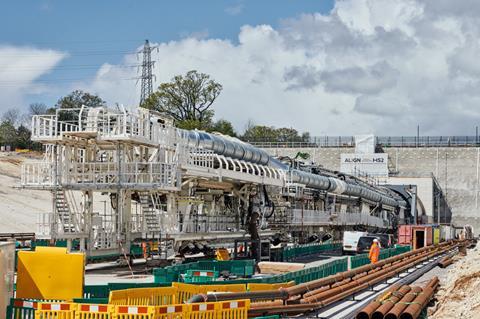
It is a pressure felt throughout the whole project’s 176km phase 1 route from London to Birmingham, but maybe nowhere more so than at South Portal. At 136 acres, it is HS2’s single biggest site. It is also the headquarters of Align, a joint venture between Bouygues, Sir Robert McAlpine and VolkerFitzPatrick which is one of the project’s four main contractors. Situated to the north-west of London just inside the M25, it is where two of the line’s biggest components converge – both being built by Align on a £1.3bn contract.
On the south side, the JV will build the Grimshaw-designed Colne Valley viaduct. At 3.4km in length, almost a kilometre longer than the Forth Rail Bridge, it will be the UK’s longest rail bridge. Supported by 56 piers with spans up to 80m long, it will carry the line’s high-speed trains to and from the underground tunnels leading from Euston station and across the swampy flatlands on the outskirts of the capital.
On the north side of the site, the trains will then enter a pair of tunnels which run for 16km beneath the Chiltern Hills. The tunnels, which are the longest on the route, will take three and a half years to complete and are being dug by two 2,000-tonne tunnel boring machines (TBMs), the largest ever to be used on a UK rail project.
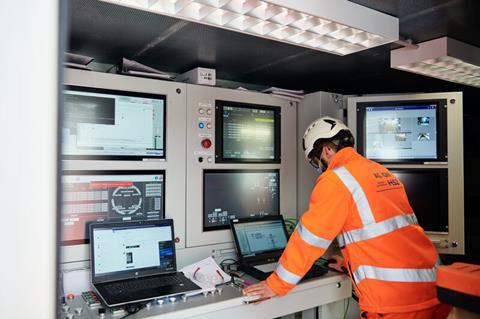
Once fully operational later this summer, they will be staffed around the clock by a crew of 17 working in shifts to keep the machines digging 24 hours a day, seven days a week. More than 100 more people will be working on the surface managing the logistics and keeping the operation going.
In the middle of the site are the two projects’ three-storey main offices – including an extra storey built during the pandemic to provide more social distancing capacity. Workers on the TBMs will sleep in a “hotel” constructed out of steel containers when they cannot get home during unsociable hours.
A sprawling complex of factories is manufacturing both the 1,000 concrete sections for the viaduct and the 56,000 concrete segments needed for each tunnel. And a huge slurry treatment plant – the largest in Europe – processes the chalk which is chipped out of the ground by the TBMs, liquified and pumped out through pipes. Overall, there are 700 staff on site, but that number will nearly double when operations are in full swing.
Opposition
With so much going on, it is perhaps surprising that the site has not been more of a focus for the protests that have stalled work elsewhere on the route. Just last month, a section of line north of the Chiltern tunnels being built by Keller was delayed by protestors. Earlier this year, environmentalists got into the South Portal site, rapidly assembled a bamboo tower at the entrance, climbed to the top and handcuffed themselves to it. The site was blocked for half a day before the protesters were cleared by police.
One sign of trouble on the horizon is the potential impact of tunnelling on the local water supply. Last month a tribunal ordered HS2 to publish unredacted documents on the risks posed to water quality after a campaign by Sarah Green, a Green party member. The documents revealed that leakage of chalk dust into the ground, though not a health risk, could require added water treatment works, and could lead to the closure of water sources entirely during construction.
HS2 Ltd senior project manager Mark Clapp said that there is “real nervousness” on the part of Affinity Water, the water supplier, and admitted that the tunnelling, a large part of which will go under the water table, does have risks. “If you were to ask, ‘is there any disturbance to the chalk in this area’, then the answer has to be ‘yes’.”
There’s a lot of work gone in, a lot of science behind what we’ve done here to make sure we have the right tools for the job
Mark Clapp, senior project manager, HS2 Ltd
To counter the problem, the TBMs can pump quick-drying slurry into any voids that appear in the earth during tunnelling as a seal. Clapp said: “There’s a lot of work gone in, a lot of science behind what we’ve done here to make sure we have the right tools for the job, and to make sure that we can respond appropriately.”
Both Affinity Water and the Environment Agency have signed off the tunnelling works after HS2 agreed to fund £100m of added filters and pumps to three nearby water pumping stations.
Despite its size, the site cuts a surprisingly low profile. The tunnel entrances are sunk into a massive U-shaped depression which has been dug into the ground, hiding the giant TBMs and support buildings from view. Besides a sign labelled with the railway’s name at the top of a discreet access road off the A412, passing motorists would be unlikely to notice that anything is happening there at all.
Only when the small group of reporters were driven in vans to the tunnel entrances and allowed to peer over the rim of the depression did the full scale of the works become apparent. Pushing against a 20m high wall carved out of the earth, the 170m long TBMs stretch across the middle of the site like train carriages.
One of them, 1205, otherwise known as Florence, is already partially underground and has dug 45m of tunnel since launching last month. The other, 1206, or Cecilia, will be powered up with 33,000 volts this week and is due to start work by the end of the month. The staggered start times are to prevent both machines tunnelling under the M25 at the same time, an agreement finalised with Highways England just two weeks before Florence was launched.
Manufactured by German firm Herrenknecht, the six sections or “gantries” which make up each TBM were shipped to the site in pieces and assembled before being transported to the tunnel portals on self-propelled modular trailers. At the front of each TBM are the 10m diameter cutting heads powered by 10 350-kilowatt electric motors hacking away at the solid chalk which lies beneath the Chilterns.
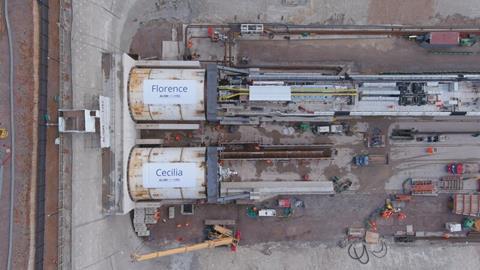
Behind this is a 20m long corkscrew to bring up the material into a “slurryfier” tank to be liquidated, followed by the machines which install the tunnel’s 8.5-tonne concrete ring sections – seven per ring – and a control cabin where workers drive the machines using a Playstation-style control pad.
Further back are giant orange-coloured robot arms, the first of their kind anywhere in the world, which remove the spacers used to separate the ring sections stacked at the front of the TBMs and insert dowels into holes in the segments’ sides to fix them in place. In the next gantry down are two “refuge chambers”, each designed to protect 12 people with enough air, food and water for 24 hours in the event of a disaster in the tunnel preventing workers from escaping.
Above the entrance to the portals is a statue of Santa Barbara, the patron saint of tunnellers, installed to watch over the workers as they enter the tunnels each day and make sure the refuge chambers never have to be used. “Tunnelers are quite superstitious,” Clapp admits.
The rear sections are partially hollow to allow vehicles carrying stacks of concrete pieces from the manufacturing site to drive right up into the TBMs and deposit them in gantry two, where the robot arm picks them up using a vacuum lift. By the time the tunnels are nearly built, this journey could be over an hour long.
It will be complicated by the construction of ventilation shafts along the route, so to prevent underground traffic jams, a series of ramps built up into the sides of the tunnels will allow vehicles to give way.
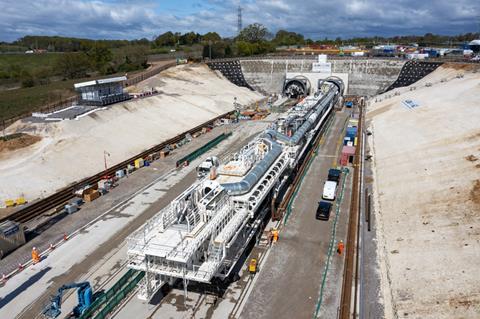
After a protracted planning period which dragged on for 10 years before Boris Johnson’s “official” launch of construction last year, speed is now paramount. Instead of waiting before each tunnel ring is fully in place, the TBMs’ cutter heads move forward by pushing against a half-constructed ring before laying the second half, a technique never before used in the UK.
The ring segments themselves are each uniquely shaped with chamfered edges to remove the need for a keystone piece, reducing the likelihood of rings having to be reset later on if they are found to have been installed in slightly the wrong position.
So far, 140 ring segments are produced each day on site, but that number will rise to nearly 200 by the end of the year. The northern portal, where the TBMs will break through in three and a half years’ time, is already being excavated.
The first passenger services on the London to Birmingham leg of the railway are due to start from 2029. After Crossrail’s four-year delay, the public might be forgiven for viewing that date with suspicion. The challenge facing Align and the other teams on the project is to prove the doubters wrong.



























No comments yet